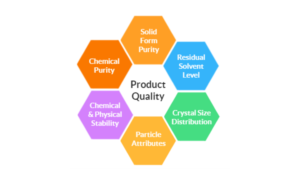In our previous blog, we provided a fundamental overview of Process Analytical Technology (PAT) and its application for various industries, including pharmaceutical and chemical manufacturing. To recap, there is an increasing demand for new approaches to understanding the chemical and physical phenomena that occur during manufacturing processes. Obtaining real-time information from processes opens new perspectives for safer manufacture of pharmaceuticals. Process Raman spectroscopy provides a molecular level of insight into industrial processes and therefore has become a promising (PAT) process analytical tool. In our latest blog, we outline the application of Raman spectroscopy as a PAT tool for crystallization monitoring and control.
Background and PAT for Crystallization
Crystallization is an important unit operation for the isolation and purification of a wide range of chemical products; including pharmaceuticals and fine chemicals. In recent years, the precise control of the crystallization process is of great significance to the improvement of the total efficiency on the production process and quality of the final products.

Robust & Efficient Crystallization Processes
Many PAT tools have been applied to crystallization process monitoring and control through several control strategies. These tools include; attenuated total reflectance Fourier transformed infrared spectroscopy (ATR-FTIR), ultraviolet-visible spectroscopy (UV/Vis), particle vision and measurement (PVM), focused beam reflectance measurement (FBRM), in situ/online image analysis, and online Raman spectroscopy. Our focus for this blog will be on Raman spectroscopy.
The development of Raman analyzers and the improvement of their measurement accuracy have increasingly been applied to the field of crystallization. The ability to accurately measure target molecules in the liquid phase and the potential to determine the crystal form of materials in the solid phase have made Raman valuable in this application space. With process Raman growing in popularity, its deployability has increased significantly making more advanced control strategies involving Raman possible. For crystallization processes, such improvements position it to be more rapidly adopted by scientists (process engineers, spectroscopists, chemists) without any specific PAT expertise.
Raman spectroscopy has several advantages over other spectroscopic techniques:
- It can measure all phases (liquids, solids, and gases), and provides high chemical specificity and excellent reproducibility
- It provides a molecular understanding of the crystallization process, can confirm that crystallization is complete, and can characterize the final solid form of the product
- Raman analysis is not hindered by the presence of water
- Raman be used a priori with crystallization such that chemometric models are not required to analyze kinetics and to detect the completion of the process
Raman Spectroscopy for Small Molecule Crystallization
To better understand and control the crystallization processes, real-time in-process information is monitored and analyzed by PAT.
Case study: Monitoring transformation of non-solvate form to solvate
Researchers at BlazeMetrics were working with a customer faced with a requirement to monitor the transformation of a non-solvate form of an API to its respective solvate. The manufacturer’s main concern was to find a robust PAT tool to follow this transformation. While BlazeMetrics instrumentation provides an excellent means of particle characterization, they often use Raman concomitantly to add the dimension of molecular characterization to the overall analysis scheme.
The experiments done by Blazemetrics discovered that the use of a Tornado HyperFlux™ PRO Plus provided a highly significant increase in signal-to-noise ratio when coupled to their instrument when compared to other Raman configurations. Based on the cost-efficiency and flexibility it would bring to operations, the PRO Plus and Blaze PFR (particle focused Raman):
- Exhibited better process details leading to better process understanding
- Better measurement reproducibility in this slurry system
- Reduced slurry-generated fluorescence allowing for cleaner extraction of information
Conclusion
Early crystallisation development can act as proactive troubleshooting. Identifying potential problems in scale up and solutions to maintaining product integrity. A robust crystallisation process can be designed and implemented using a combination of modelling and PAT, pre-empting unwanted forms, and process problems.
If you would like to discuss your application and are considering adopting Raman spectroscopy as a process analytic technology, please contact us at [email protected]



